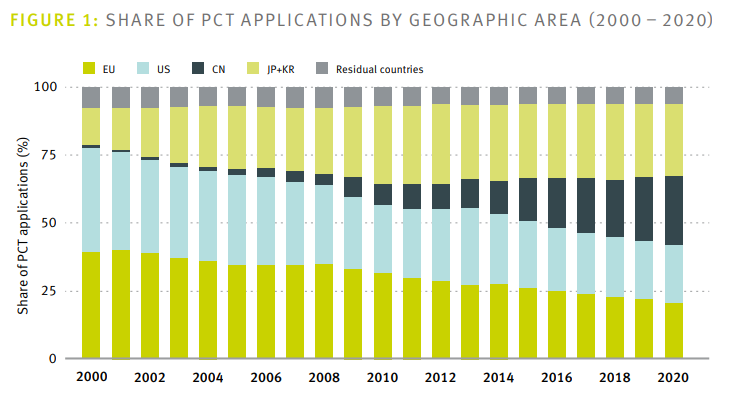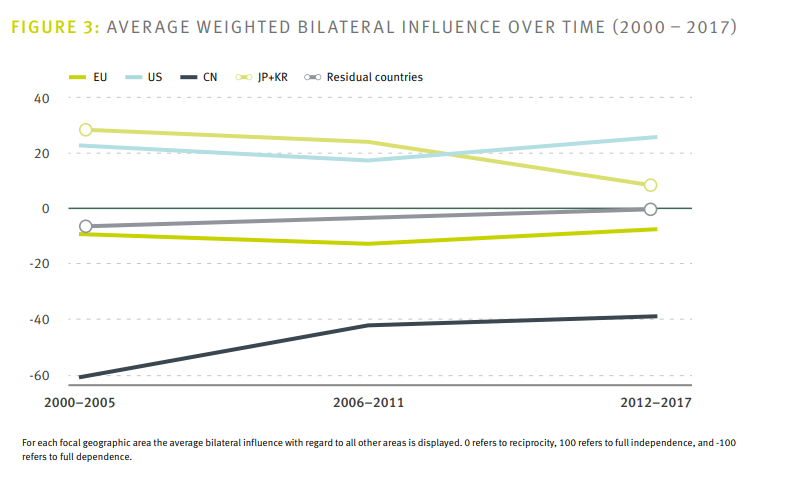Patents & the geoeconomics of innovation: the USA remains the world’s brain

Share
The global economic landscape has changed fundamentally since the fall of the Berlin Wall. Following this historic event, an American political philosopher, Francis Fukuyama, predicted the end of history. Economic globalization would continue without encountering major obstacles. Thirty years and a global pandemic later, the tone has changed. The pattern of unstoppable globalization has been replaced by a renewed concern for the risks associated with excessive economic interdependence.
This change has given rise to a debate on technological sovereignty, a concept that refers to a country’s ability to control and supply the technologies that are essential to its competitiveness and well-being. Technological sovereignty differs from domestic autarky or technological self-sufficiency. The aim is not to develop all technologies in one’s own country, but – when acquiring technologies abroad – to avoid unilateral dependence on a particular country.
The importance of taking technological sovereignty into account has become clear during recent economic and political crises, for example during the Covid pandemic or with problems related to the supply of semiconductors. This is also the case when we consider the trade tensions between the United States and China in the high-tech sector, and the war in Ukraine.
Reliable partners
Faced with these concerns about sovereignty, political decision-makers are looking to reduce technological dependency, and to do so, are seeking information about their country’s relative position in relation to other regions of the world. The aim? To reconsider or revisit certain trade relations, in favor of trade with partners who are both geo-economically reliable and share the same values. And that’s only possible if you have good information on the reality of innovation in different parts of the world.
To do this, we analyzed technological sovereignty, breaking down global invention activity into four economic regions, namely Europe, the USA, China, & Japan and Korea. By examining thousands of patent applications from the international patent system (PCT) between 2000 and 2020, we were able to analyze how the global positioning of these regions has changed over the past two decades.
Specifically, we examined the strength and direction of invention influence at global and bilateral levels. To do this, we developed a measure that uses citations generated by International Search Reports (ISRs) during the international phase of PCT applications. This enables us to calculate the extent to which inventions in one geographical area form the basis for inventions in other areas.
The PCT international patent system is administered by the United Nations World Intellectual Property Organization (WIPO) and provides intellectual property protection in 157 countries.
Almost threefold increase in applications
Use of the PCT system has risen significantly, from 97,414 applications in 2000 to 254,008 in 2020. This growth is strongly influenced by countries in East Asia, with China leading the way in filings since 2019. The shift in innovation activity from the West to East Asia is clear. In 2000, over three-quarters of PCT applications still came from the USA and Europe. 20 years later, more than half the world’s PCT applications came from China, Japan and Korea.
Driven by countries in Asia, patent registrations have more than doubled in 20 years

Caption: Europe here covers the 27 members of the European Union, plus Norway, Switzerland and the United Kingdom. (Source: authors/ ©ZEW Policy brief)
However, the increase in patent filings only partially measures the real influence of inventions. Our research focused on citation data for PCT applications between 2000 and 2017. The results enable us to put the previous conclusions into perspective. First and foremost, this method reveals that the USA retains its status as the leading technological superpower, exerting a strong global influence.
By studying the frequency with which a patented invention is taken up by a different region, as an indicator of average global influence, we find that the USA occupies the leading position. Compared to European patents, American inventions are almost twice as often taken up by another region. In comparison with China, Japan and Korea, the American advantage is even greater.
Next, to measure bilateral influence, we studied the frequency with which patents from one region are used as a basis for subsequent inventions by the partner region in question, and vice versa. If a region’s patents are used relatively more frequently, then it exerts a stronger bilateral influence.
Once again, the United States outperforms all other regions on this criterion. More precisely, it occupies a position of strength in relation to the other three regions considered. Despite close integration between the USA and Europe in terms of bilateral knowledge flows, Europe consistently has a lower level of influence than the USA.
Although China has filed the largest number of patent applications in recent years, it remains dependent on all other geographic zones. Japan and Korea, on the other hand, used to occupy a leading position, but have seen their average bilateral influence decline over time.
China remains dependent on the rest of the world for innovation

(Source: authors/ ©ZEW Policy brief)
Europe is relatively strong in key technologies, although the USA can also lay claim to top position in this area. These are forward-looking technologies – such as advanced materials, industrial biotechnology and microelectronics – which are particularly important for future economic development. For inventions in these technologies, Europe’s global influence is above the world average.
Policy implications
These results should encourage American policymakers to defend their strong position. While the country no longer leads the world in patent filings, it remains dominant in terms of the global influence of its inventions. European policymakers, meanwhile, could focus on promoting key technologies, an area in which the region has already acquired a relative advantage. At the same time, Europe should make every effort to reduce its future dependence on Chinese innovations.
Current world events pose a challenge for Chinese policymakers. While China improved its bilateral influence in the 2010s, its growth has slowed and is now similar to that of the USA and Europe. Our results suggest that China is not on the verge of overtaking the USA as a technological superpower.
Finally, Japan and Korea have made significant contributions to global innovation in previous decades. However, especially in Japan, the most recent innovations have not yet been convincingly translated into international influence vis-à-vis its partners. Japan’s political decision-makers should therefore address this issue as soon as possible, especially as its economy faces the challenges of an ageing population.
Whatever decisions are ultimately taken by the various governments, our study reminds us that, even if the United States defends its position as leader, China has seen the greatest increase in its global influence over the last two decades.
While unconstrained global economic integration has lost some of its popularity, collaboration between like-minded, geo-economically reliable partners still enables countries to benefit from their inclusion in global innovation networks. However, dependencies linked to cooperation with less reliable countries should be reduced over time, while strengthening inventive capacity at home or among reliable partners.
Elisabeth Mueller, Full professor of innovation and entrepreneurship, IÉSEG School of Management.
This is a translated version of an article published on The Conversation France. Read the original article in French that is co-authored by Philipp Boeing (Goethe University, Frankfurt and ZEW – Centre for European Economic Research, Mannheim).



